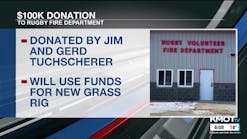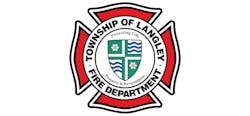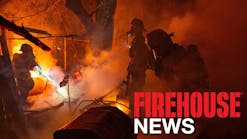Fast-Moving: What’s New in Wildland Apparatus
The 2020 U.S. wildfire season was particularly busy, scorching more than twice the area than that which was lost in 2019. According to the National Interagency Coordination Center (NICC), more than 10.1 million acres were burned compared with 4.7 million in 2019.
These figures don’t consider every smaller brush, field and woods incident that generated a local response.
California was hit particularly hard. Union of Concerned Scientists reported that five of the six largest blazes in the state’s history were recorded in 2020.
Regardless of the size or location of the fire, specialized rigs responded to the call. In days gone by, wildland apparatus often were thought of as being solely part of northwestern forest agencies, doing battle in the tall pines, or perhaps serving in New England or Long Island, where they faced challenges that were created by slightly different landscapes. These rigs often appeared on the nightly news, working alongside conventional engines in the canyons of California, as part of herculean efforts to save million-dollar houses. However, with the continuous expansion of the wildland urban interface (WUI), the rigs truly can be found nationwide.
It once was common for these vehicles to be crafted from surplus military gear, suitably outfitted for fighting fires in rugged terrain and bearing the monikers “swamp buggy,” “stump jumper” and “brush buster,” among others, depending on where they were stationed.
As the needs of the fire service change, so do the features and functions of our apparatus. Although NFPA 1906: Standard for Wildland Fire Apparatus establishes minimum requirements, further refinement may be made. The National Wildfire Coordinating Group, for example, categorizes engines from Type 1 to Type 7, with Types 3, 4, 5, 6 and 7 for wildfire use. The bottom line is that the end user, as is normally the case, lays out a unit that best addresses local needs. Even New York City has apparatus that are designed specifically for brush and utility assignments.
Numerous innovations tied to purpose-built wildland units emerged recently.
Joysticks and TICs
Past practices often called for a firefighter(s) to ride the extended front bumper of the brush buggy to extinguish the blaze. Seats sometimes were mounted in this position to accommodate the tactic. Short lengths of booster line were provided to that individual to aid in extinguishment. This practice obviously wasn’t labor efficient, but moreover, it also was downright dangerous. The operation was fraught with potential mishaps, including the possibility of running over a crewmember.
A much better alternative is an automatic turret that is operated via joystick. The officer then can direct the stream—with a much greater reach than handlines—from the relative safety of the cab.
Thermal imaging cameras (TICs) are an established fire service tool. Their uses traditionally include the location of victims, finding the seat of a fire and tracking down hotspots during overhaul. Assisting wildland apparatus navigate the fireground can be added to this list.
Just as is the case with their use in a structural firefighting environment, TICs can provide vital information that isn’t visible through the smoke, can help to avoid hazards that otherwise are unseen and can be useful in aiming remote-controlled monitors.
Designed for multipurpose use
Although many wildland units formerly were relegated to limited duty, municipal agencies now design them to do much more than respond to wildfire calls.
“In the past, many departments seemed to treat brush trucks as a secondary support vehicle, with the sole purpose of going out and fighting a grass fire,” Bill Davidson of Skeeter Brush Trucks says. “Now, we are showing again and again that if you are able to invest 10 percent to 20 percent more in the fabrication of your apparatus and set it up to handle the wildland role and these other calls, you’re going to get a heck of a lot more than just a 10 percent to 20 percent increase in usability out of that same truck that would have otherwise been left sitting in the station until a grass fire came in.”
Adding tank and pump capacity to wildland apparatus that also are made more maneuverable aids in this versatility. To this end, SVI Trucks developed an apparatus that has a 750-gallon water tank and a 1,250-gpm PTO pump, according to Jason Kline, who is the manufacturer’s Colorado/Wyoming sales manager. The vehicle has a shorter wheelbase than is typical and includes a booster reel, cross-lays and a full complement of ground ladders.
Extended deployments
For vehicles that have a chief function of wildland operations, thought is being given to what that means in the vein of extended deployments. Whereas most conventional apparatus return to quarters quickly after a call, those that are assigned to task forces or forest services might remain on scene for a week or more.
“One of the biggest things that we have seen is fire departments working on designing apparatus that are capable of being deployed on fires for 14 days,” Kline says. “This increased the amount of equipment being carried. Fire departments are designing apparatus that have an extra amount of storage for this.”
Technology transfer
The utilization of compressed air foam systems (CAFS) on wildland apparatus is increasing daily. With vehicles being designed and constructed for multipurpose response, the inclusion of this alternate extinguishing agent adds to the firefighting capacity and versatility of smaller vehicles.
Advances in LED (light-emitting diode) lighting, which now is used commonly on structural apparatus, has made the transition to smaller fire apparatus, as have roll-up compartment doors.
As is the circumstance with seemingly everything these days, even the stalwart blueprint has gone digital.
“Three-dimensional modeling and continuous improvement in CAD (computer-aided design) standards enable faster design cycles with custom builds and configurations,” Glen Garrettson of Boise Mobile Equipment (BME) tells Firehouse Magazine. “Clients can see their models in 3D before the unit is built, improving the customer experience.”
This technology transfer isn’t limited to sources that are within the fire service.
“What we are doing here is combining the components and knowledge from other related markets and other areas of the fire service to get the most out of our trucks,” Davidson says. “For example, we look to the military vehicles and have begun to bring features, such as central tire inflation systems (CTIS), along with components, such as planetary axles, that have a much higher safety margin built into them than what you would find in a standard OEM piece of hardware.”
More requires more
The significant increase in wildland fires has led to a corresponding increase in innovation in wildland apparatus. Where will the future take us? With the NICC reporting that the five most devastating fire seasons in history occurred this century, the future likely will take us to a greater than average number of wildfires, and we’ll get there in wildfire apparatus that push the technological envelope.
Converting an Existing Vehicle
Although not new in concept, many fire departments in the United States and Canada are addressing their evolving wildland apparatus needs by turning to in-house conversions as more options for converting become available.
Jerry Halpin, who is the vice president of sales for CET Manufacturing, says that he has seen a significant increase in both skid and glider units from both municipal and forestry departments. These are mounted on commercial vehicles, providing either a basic tank and pump or a more inclusive fire protection package, respectively.

Barry Furey
BARRY FUREY, who is a Firehouse Contributing Editor, provides consulting and training services in emergency communications. He is the former director of the Raleigh-Wake Emergency Communications Center in North Carolina. During his 50-year public safety career, he has managed 9-1-1 centers and served as a volunteer fire officer in three other states. In 2005, Furey received a life membership in the Association of Public-Safety Communications Officials (APCO) International for his continued work in emergency communications. Furey was inducted into the Firehouse Hall of Fame in 2017.








